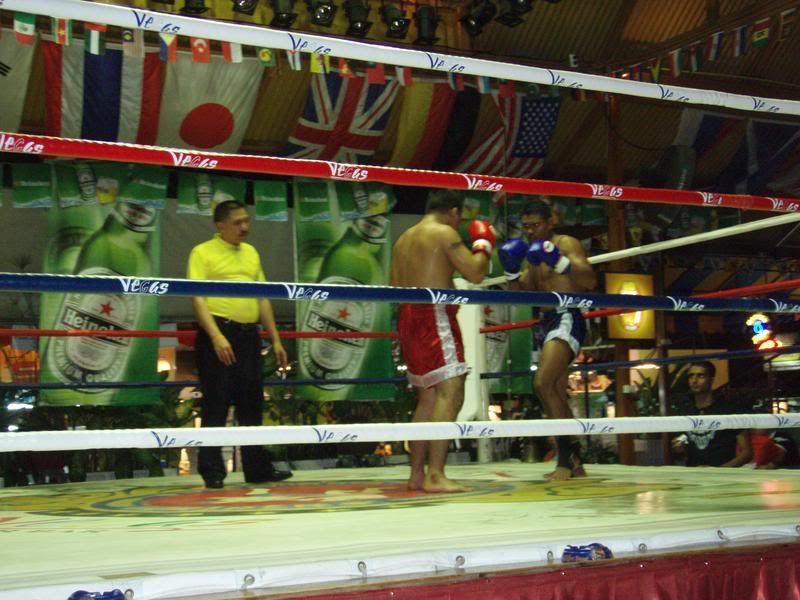
There is a definite pace to a muaythai bout and, with a few exceptions, seems to follow a basic format. Round one is slower than the rest, with single blows thrown more often than combinations, and power held back to as much as 40 or 50 percent. The slower pace serves several purposes. It allows each fighter to assess their opponent, experiment with their “tools” and figure out their range.
During round two, the action begins to pick up. Depending on the skill level of the fighters and the importance of the bout toward their fighting careers, round two can see anything from a slight increase in activity to an all-out war. The boxers begin putting together combinations in earnest. There is action, but oftentimes there is a lot of, literally, “hit-or-miss” going on as the contestants figure out what works, what doesn’t, and how close they need to be in order to execute effectively.
Following the second round, the betting in the stands accelerates. I have been told that there are two minute breaks between each round to accommodate the audience’s betting addiction. This many be true, but given the energy output necessary for these young men, I would guess they appreciate all 120 seconds.
Rounds three and four are the big rounds. Barring a knock-out, it is in these rounds that the fight can often be determined. The competitors, no longer testing each other, let go their weapons with full speed and power. Generally, there is much more use of the knees and elbows (the tools Thais consider most deadly), and fighters dispense with caution and excessive defense in order to deliver explosive combinations without quarter.
There is nothing dull about the third and fourth rounds of a good muaythai bout. Not only has the ring action accelerated to peak pace, the gamblers behave as if they themselves are in the ring (certainly their money is). They yell encouragements, wave their arms and scream, “oyea, oyea!” for each knee thrust thrown into a rib or body organ. Betting continues as the battle wavers first toward one fighter then another.
Round five can vary depending on the previous rounds’ events. If it is a championship match, or if both fighters seem to be equal in points accrued, the action will remain high. If there is a grudge between competitors or the bout is a rematch, this may also be the case. But if, as is often the case, one fighter demonstrated his superior skill in the previous rounds, the final round may reflect the first. The gamblers have lost interest, the band’s tempo slows, and the fighters finish their commitment with a little less speed and viciousness.
Muaythai is a demanding sport, requiring consistent aerobic activity interspersed with anaerobic blasts of action. Not only must a fighter be skilled in powerful offense, quick defense and impeccable range and timing, he or she must also be in brilliant aerobic condition. The regime of a Thai fighter reflects this need and even amateurs who are taking their sport seriously train between 16-25 hours or more each week. Add to this the age and testosterone levels of the young men competing in venues such as Lumpini, and you’ve got a formula for an electrifying contest.
For some, it is easy to judge and criticize muaythai as violent and obscene. I have spoken to many a visitor to the Kingdom who refused to attend an evening of fights because they could not stomach such brutality. I understand. Over the years I have grown to detest the kind of gratuitous violence so popular on television and movie screens these days.
But there is something about muaythai that I cannot dismiss on grounds of excessive aggression. Perhaps it is the superior athleticism of its practitioners, or its pristine and savage grace. Perhaps it is the true sportsmanship with which its practitioners engage their art. Perhaps it is my “insider” knowledge of a fighter’s experience that allows me to enjoy these displays of mutual physical punishment and strategic challenge. But perhaps it is the history of Thailand, (a nation able to avoid colonization through political strategy and brutal defense both), that makes me appreciate the fighting art that represents their fierce independence and historical success as a free people.

2 comments for “Muaythai Musings”